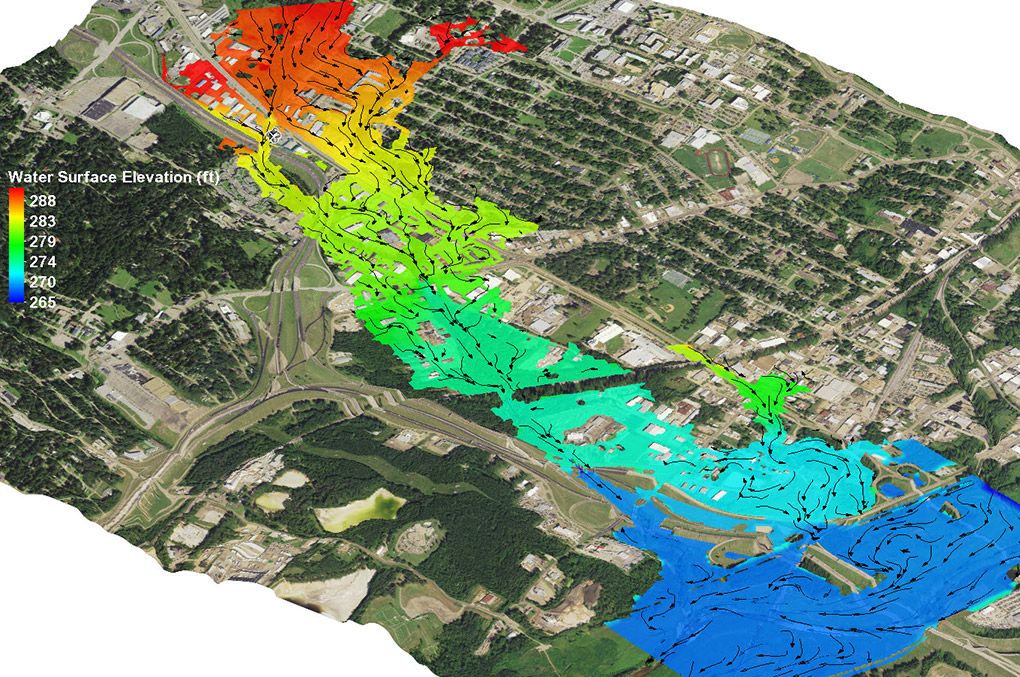November 15, 2018
Innovation of the Month:
Collaborative Hydraulics: Advancing to the Next Generation of Engineering
Collaborative Hydraulics: Advancing to the Next Generation of Engineering (CHANGE) can help transportation agencies better understand the complex interactions between waterways and transportation assets and improve project design and delivery.
The Georgia Department of Transportation (GDOT), which used two-dimensional (2D) hydraulic modeling on four projects, now requires the use of 2D modeling on projects where water flow passes through multiple bridge openings and encourages its use for other appropriate projects. GDOT finds that 2D modeling provides more accurate water surface elevations and distribution of flows through multiple openings.
The Maine Department of Transportation is applying 2D hydraulic modeling on three projects. The agency finds that using 2D modeling reduces the amount of guesswork needed to model complex flow conditions, such as when bridge and culvert alignments are at an angle to the approaching flow or other site conditions generate turbulence and eddy formations.
The New Mexico Department of Transportation (NMDOT) used 2D modeling in parallel with conventional one-dimensional (1D) hydraulic models on multiple bridge replacement projects to compare the benefits and challenges of using this innovation. NMDOT reports that the results from 2D hydraulic modeling appear to be more accurate and detailed than what 1D hydraulic models provide. The agency also found that 2D hydraulic models can be developed faster and with more confidence than similar 1D models.
Contact Scott Hogan of the Federal Highway Administration Resource Center for information and technical assistance.
See FHWA's New Guide to Improve Pedestrian Safety at Uncontrolled Crossings
As part of the Every Day Counts program on safe transportation for every pedestrian, FHWA published an updated "Guide for Improving Pedestrian Safety at Uncontrolled Crossing Locations" to help agencies choose countermeasures based on roadway characteristics and pedestrian safety issues. The guide includes information on the rectangular rapid-flashing beacon (RRFB) countermeasure. RRFBs are active (user-actuated) or passive (automated detection) amber light-emitting diodes that use an irregular flash pattern at midblock or uncontrolled crossing locations, significantly increasing driver yielding behavior. The guide is supported by an updated "Field Guide for Selecting Countermeasures at Uncontrolled Pedestrian Crossing Locations" that helps practitioners document relevant roadway conditions, traffic information, and safety data. For information, contact Becky Crowe of the FHWA Office of Safety.
Public Roads Features EDC-5 Innovations
See the autumn issue of FHWA's Public Roads magazine for "Introducing the EDC-5 Innovations," an Innovation Corner article on the technologies and practices in round five of the Every Day Counts program to accelerate adoption of proven but underused innovations. The EDC-5 innovations support the U.S. Department of Transportation priorities to enhance safety, improve infrastructure, deploy innovation, and serve the Nation efficiently and effectively. Sign up for the electronic version of Public Roads.
About EDC
Every Day Counts, a State-based program of the Federal Highway Administration’s Center for Accelerating Innovation, works with State, local, and private sector partners to encourage the adoption of proven technologies and innovations to shorten and enhance project delivery.



